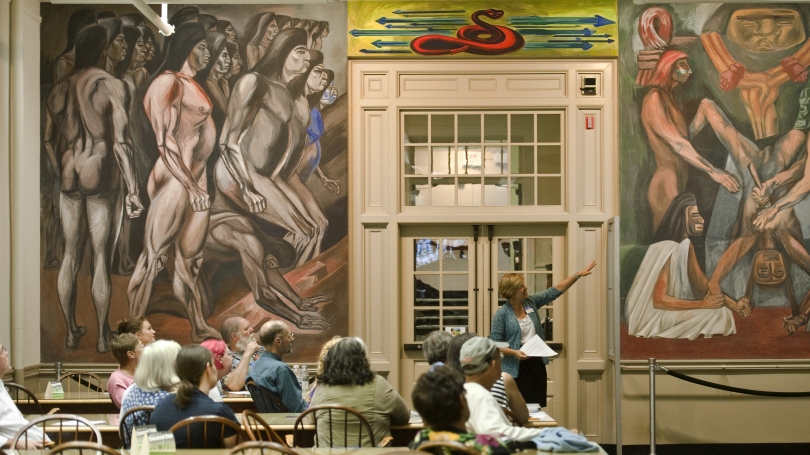The Orozco mural cycle, one of Dartmouth's greatest treasures, has been designated a national historic landmark, one of thirteen new landmarks announced on March 11, 2013, by Secretary of the Interior Ken Salazar and National Park Service Director Jonathan B. Jarvis.
José Clemente Orozco's The Epic of American Civilization, created between 1932 and 1934 while Orozco was artist-in-residence at Dartmouth, challenged traditional thinking about the development of Aztec and Anglo-American civilizations in North America. The renowned Mexican muralist conceived the murals—located in BakerBerry Library—as a representation of a North American continent characterized by the duality of indigenous and European historical experiences.
"It is gratifying that Dartmouth's showcasing of the most significant work of Orozco's career has been recognized as a prominent destination in telling our nation's rich and diverse story," said then–Dartmouth Interim President Carol L. Folt. "The murals provide an unparalleled opportunity for Dartmouth students studying art, and for our community, to experience one of Mexico's foremost artists of the early twentieth century."
Dean of Libraries Jeffrey Horrell said, "This is a wonderful opportunity for Dartmouth to be able to share the Orozco murals with the country and the world, and for Dartmouth to have this designation. I'm sure it will encourage many more visitors to come to Dartmouth."
The murals are housed in the newly named Orozco Room in the library's ground-level reserve reading room. The mural space underwent major renovations last summer and fall, reopening in October after new lighting and comfortable seating were installed, with funding from the Manton Foundation. The project took place during Dartmouth's arts initiative titled Year of the Arts.
Orozco (1883–1949) was Dartmouth's second artist-in-residence at a time of intense growth and activity in the institution's art department. Art history professors Artemas Packard and Churchill Lathrop brought the prominent Mexican artist to campus to teach the art of fresco painting to students. During that residency, the idea for the commission of a mural was proposed, and later supported by then–Dartmouth President Ernest Martin Hopkins.
"Orozco's work is one of the finest examples of Mexican muralism in the United States and arguably the artist's greatest work," said Hood Director Michael Taylor. "Commissioning Orozco to paint this mural in Baker Library in the early 1930s represents a daring moment in Dartmouth's history, and the decision to designate The Epic of American Civilization as a national historic landmark will preserve this masterpiece of modern art for generations to come."
National historic landmarks are nationally significant historic places that possess exceptional value or quality in illustrating or interpreting the heritage of the United States. The program, established in 1935, is administered by the National Park Service on behalf of the Secretary of the Interior. Currently there are 2,540 designated national historic landmarks.
"This is a big deal, no doubt about it," said National Park spokesman Mike Litterst. "This is the highest distinction that a site can get from the Secretary of the Interior. There are people who make plans to go out of their way to visit national historic landmarks."

